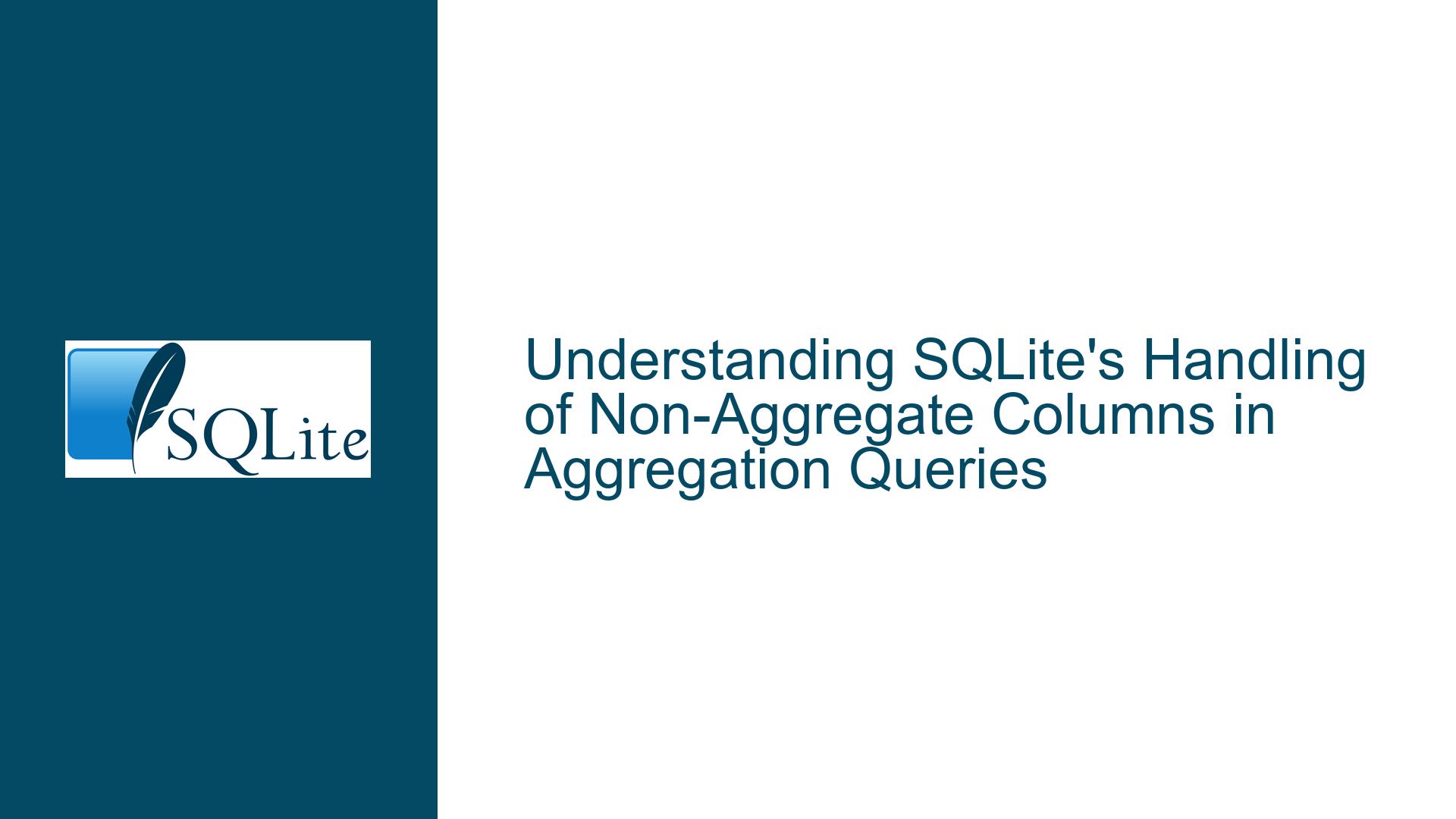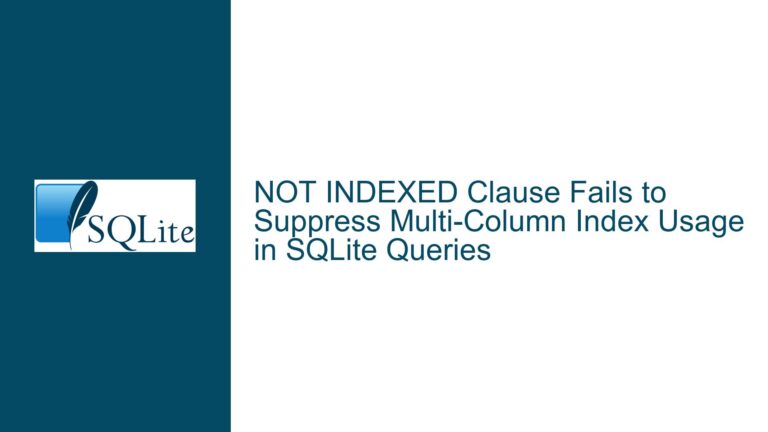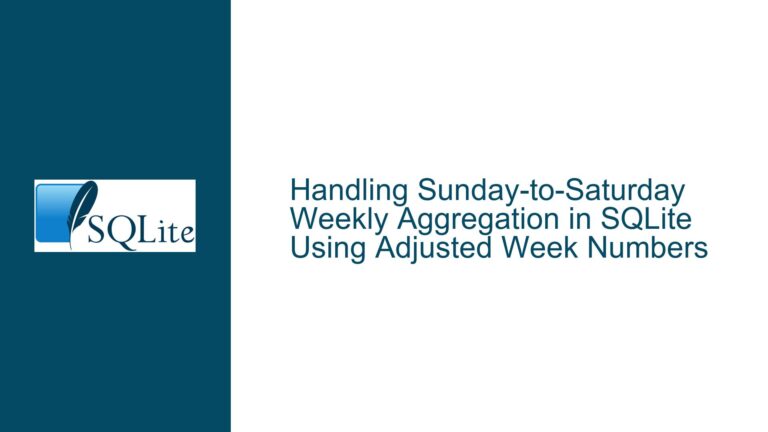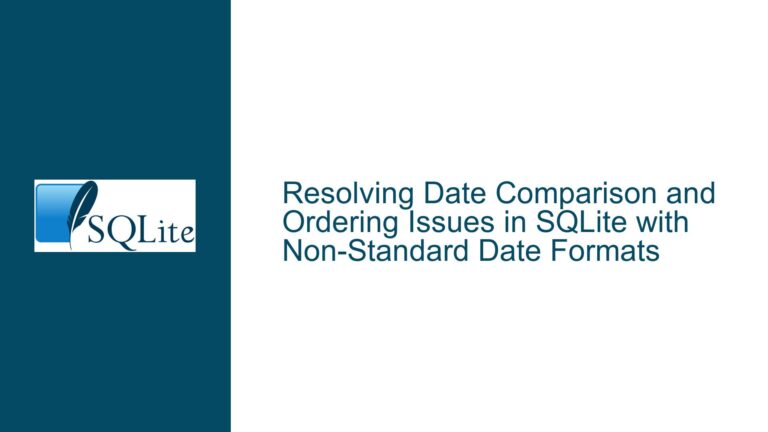SQLite’s Handling of Non-Aggregate Columns in Aggregation Queries
SQLite’s Behavior with Non-Aggregate Columns in Aggregation Queries
SQLite’s approach to handling non-aggregate columns in aggregation queries is unique compared to other SQL database systems. When performing an aggregation query, SQLite allows the inclusion of non-aggregate columns in the SELECT clause that are not functionally dependent on the grouped columns. This behavior can be both a powerful feature and a potential source of confusion, especially for those new to SQL or coming from other database systems where such queries would typically result in an error.
In SQLite, when you include a non-aggregate column in the SELECT clause of an aggregation query, SQLite will select a value from one of the rows in the group. If you request multiple non-aggregate columns, all these columns will be taken from the same row within the group. This can be particularly useful for queries where you want to retrieve additional details from the row that contains the minimum or maximum value of a certain column. However, this behavior can also lead to non-deterministic results when used with other aggregate functions, as the selected row might not be meaningful in the context of the query.
This feature is not without its critics. Some argue that it can lead to unexpected results, especially for those who are not aware of this behavior. For example, if a user mistakenly omits a column from the GROUP BY clause, SQLite will not raise an error but instead return a result that might be incorrect or nonsensical. This can be particularly problematic in educational settings where students are learning SQL and might not immediately understand why their queries are returning unexpected results.
The Debate Over SQLite’s Aggregation Behavior
The discussion around SQLite’s handling of non-aggregate columns in aggregation queries often centers on the trade-offs between flexibility and strictness. On one hand, SQLite’s approach allows for more concise and powerful queries, especially in scenarios where you want to retrieve additional details from the row that contains the minimum or maximum value. This can save a significant amount of time and effort compared to other databases where you would need to write more complex queries or use subqueries to achieve the same result.
On the other hand, this flexibility can lead to confusion and errors, particularly for those who are not familiar with SQLite’s behavior. In other SQL databases, such as PostgreSQL, queries that include non-aggregate columns without a corresponding GROUP BY clause would result in an error. This strictness helps prevent mistakes and ensures that the results of aggregation queries are always meaningful and deterministic.
The debate is further complicated by the fact that SQLite’s behavior is not just a matter of preference but also a matter of compatibility. For those who are used to working with other SQL databases, SQLite’s behavior can be surprising and lead to errors that are difficult to diagnose. This is particularly true in educational settings where students might be learning SQL using SQLite but will later work with other databases that enforce stricter rules.
Implementing a Stricter Mode for Aggregation Queries in SQLite
Given the potential for confusion and errors, there has been discussion around the possibility of implementing a stricter mode for aggregation queries in SQLite. This mode would enforce rules similar to those in other SQL databases, where non-aggregate columns in the SELECT clause must either be part of the GROUP BY clause or be used within an aggregate function. This would help prevent common mistakes and make SQLite more consistent with other SQL databases.
One proposed solution is to introduce a new configuration option, such as SQLITE_DBCONFIG_STRICT_AGGREGATE, that would enable this stricter mode. When enabled, SQLite would reject queries that include non-aggregate columns in the SELECT clause without a corresponding GROUP BY clause. This would provide a way for users to enforce stricter rules when needed, particularly in educational settings or when porting queries from other databases.
However, implementing such a feature is not without its challenges. One of the main concerns is that it could break backward compatibility with existing applications that rely on SQLite’s current behavior. Additionally, there is the question of how to handle cases where the non-aggregate columns are functionally dependent on the grouped columns. In PostgreSQL, for example, non-aggregate columns are allowed in the SELECT clause if the primary key of the table is included in the GROUP BY clause, as this ensures that the result is unambiguous. Implementing similar rules in SQLite would require additional complexity in the query planner and could impact performance.
Another consideration is the impact on the simplicity and ease of use that SQLite is known for. One of the reasons SQLite is so popular is its simplicity and the fact that it "just works" in most cases. Adding a stricter mode for aggregation queries could complicate the user experience and make SQLite less accessible to beginners.
In conclusion, while SQLite’s handling of non-aggregate columns in aggregation queries offers a powerful and flexible feature, it also has the potential to lead to confusion and errors, particularly for those new to SQL or coming from other database systems. Implementing a stricter mode for aggregation queries could help address these issues, but it would need to be done carefully to avoid breaking backward compatibility and complicating the user experience. As with many things in software development, the best approach will depend on the specific needs and constraints of the users and applications involved.






